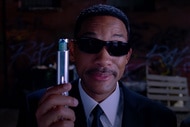Create a free profile to get unlimited access to exclusive videos, sweepstakes, and more!
The Invisible Man's tech is (sort of) within sight

The Invisible Man first entered the pop culture landscape in the form of a novel by H.G. Wells, in 1897. The story follows Griffin, a scientist interested in optics, who discovers a way to alter his body such that it doesn't interact with light. He is thus rendered invisible — provided he's totally naked, of course. However, in the new film adaptation of The Invisible Man, starring Elisabeth Moss, clothes make the Invisible Man. It's a modern update — and a plausible one.
Could someone actually make a high-tech suit that makes them totally invisible?
**Spoilers for The Invisible Man below.**
In both the novel and the original 1933 film, Griffin renders himself invisible through the use of exotic chemicals. In the 2020 film, he's traded in his chemistry set for an advanced suit that uses an array of cameras and displays to record the wearer's surroundings and transmit them on its surface. It's invisibility by way of technological trickery. Less magic and more active camouflage, but it gets the job done.
Accomplishing invisibility has long been one of those hallowed technological feats, perpetually in the distant future. Like teleportation or time travel, it's the sort of thing that seems maybe possible, yet wholly beyond our grasp. The way it's portrayed in the recent film removes it somewhat from the realm of techno-magic, planting at least one foot into the realm of possibility.
In fact, it sort of already exists…
HYPERSTEALTH
Created by Hyperstealth Biotechnology Co., the material known as Quantum Stealth (which sounds like either the name of a scented men's deodorant or a video game from the '90s) works by bending light through a thin material and around an object behind it.
Version One of the material is something you're probably already familiar with. It's the same stuff that makes lenticular images work. You know, those cool Magic Motion-style pictures that change depending on the angle you're looking at them from? Who'd have thought your Lisa Frank bookmark might have military applications?
Guy Cramer, President and CEO of Hyperstealth, got started designing camouflage (the boring kind) uniforms for the military. This new endeavor is an extension of those efforts. They've submitted several patents for various versions of the material, each of which uses a different configuration of layers and intermediary materials to achieve different effects.
To be clear (pun intended), Quantum Stealth isn't perfect. You can't wear it, and it does not achieve true invisibility in the Wells-ian sense. It's obvious to any close observer that the screen is there. It does, however, make it difficult or impossible to tell what's behind the screen.
Demonstrations in the above video pretty clearly illustrate how it might be useful in hiding objects from outside observers.
OPTICAL CAMOUFLAGE
While Hyperstealth's materials are impressive and have applications under a number of specific circumstances, accomplishing a suit like the one Griffin wears in this new film adaptation — allowing for continuous invisibility under any circumstance — takes a bit more work.
You could achieve a lo-fi version of what's seen in the movie at home using objects you probably already have: namely, a couple of smartphones or tablets.
By strapping two devices, one to your front and one to your back, and starting a video call, you can create the illusion of invisibility, at least over a small portion of your body. It's particularly useful in Halloween costumes, as seen in this video.
Griffin's suit is essentially a scaled-up version of that simple concept. His suit takes real-time video of the world around him and displays it on the surface of the suit.
Using flexible displays — which have been developed for a few years now but have yet to hit mass-market — and an array of 360-degree cameras could get you something pretty close to what we see in the film. It would achieve essentially the same effect, but it would likely still be pretty obvious that someone was standing in front of you, even if you couldn't see who it was.
The real barrier to true invisibility seems to be resolution and computing power.
Even if we built a full-body suit out of flexible displays, capable of recording its surrounding and displaying them on the surface, it wouldn't be able to do so in exactly real-time or at a resolution that would match perfectly to the real world.
You'd end up with the sort of invisibility we see in video games, wherein characters are semi-transparent but visible, especially when moving.
It seems reasonable, though, that a suit of this nature is only a matter of time. As computing power, screen resolution, and materials science improves, the hurdles to an invisibility suit will be overcome.
APPLICATIONS AND ADDITIONAL HURDLES
While there are obvious military and governmental applications for this sort of technology, it's difficult to imagine what non-malicious uses the average person could have for rendering themselves unseen.
It's likely that, once a true invisibility suit is developed, the cost barrier will keep it almost entirely in the hands of governments, which is a little frightening, to say the least.
The same technology could be used, not to make people invisible, but surfaces. Sections of your car's interior could display the world outside, eliminating blind spots. Homes could be equipped with sections of invisibility, instead of windows, reducing the energy cost of maintaining an internal temperature and making the home more difficult to penetrate while still giving you a window to the outside world.
As these materials and technologies become more readily available, new uses will arise that will invariably improve our lives, but making ourselves invisible probably isn't one of them.
The good news is, even if there were people running around in digital invisibility suits, there would be one pretty easy way to find them: heat.
A suit made entirely of cameras and displays would generate a considerable amount of heat. Ever put your hand near your computer tower after an hour or two of gaming? Anyone suspicious of being stalked by the Invisible Man would need only to use thermal imaging to seek him out. A series of cameras and displays can trick the human eye, but you can't beat thermodynamics. Moreover, anyone inside the suit would leave puddles of sweat everywhere they go.
Though, who knows, maybe future scientists will figure that out, too. Then we'll be in real trouble.




























